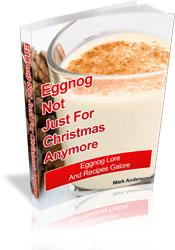| 
"Eggnog—Not Just For Christmas Anymore!" will eggs-ceed your expectations! Buy Ebook Now for Only $9.95!
Right Now buy this ebook for just $4.95 a special holiday sale!
"Excellent!" Erik H., Colorado "Searching for the right recipe can be overwhelming. Mark breaks down eggnog recipes for you with his helpful monthly suggestions! If you are like me, and still crave eggnog after the holidays, the "January " section is a great place to start!" Selina P, Minnesota "In the past, it has always been really difficult to find non-alcoholic eggnog recipes for guys like me. No longer--that's why I love 'Eggnog--Not Just For Christmas Anymore!'" John A, United States Army, Afghanistan

Just $4.95
a special holiday sale!
|
Eggnog History From Ancient Rome
The earliest eggnog recipe I’ve uncovered was a first century egg sponge published and copyrighted by the Archaeological Institute of America in 2001.
Mix together the following:
3 eggs
1 1/8 cup milk
1 oz olive oil
Put a little olive oil into a shallow pan and bring it to a boil. Pour in egg mixture. When the mixture is done on one side, turn it out onto a serving dish and then coat it with honey and cracked pepper.
This recipe is based on the work of author Edith Evans of the Glamorgan-Gwent Archaeological Trust who wrote of Roman cookery ("Dining with the Ancients," pp. 54-61). In her article, Evans used the recipes of the famous Roman chef and author Apicius. Even this recipe has been “slightly revised” by the editors of the Archeological Institute of America.
Eggnog History in The Early Middle Ages
Some writers suppose that eggnog history is tied up with the practice of wassailing and toasting. This may well be the case. An interesting presentation entitled THE HISTORY & RITUAL OF "THE TOAST" given by Luis J. Orozco II, El Camino Research Lodge, refers to eggs, beer and a toast. This was a Paper Submitted and Read toThe Britannia Council No. 303 Allied Masonic Degrees onJune 1994. It includes some eggnog history from a Masonic perspective.
In prayer we find the most reverent as well as relevant use of drink and its symbols. It has been used to toast the gods since time began. Often in strange ways, but in all times man has so revered his drink, as to wish to share it with his gods. Early Northern Europe beers were often mixed with egg. (Emphasis added) It seems the egg in ancient mythology was a pronounced symbol of life everlasting with promises of divine reward. When included in beer it often became the tool of communication with the deity via a hardy toast offering. While the beer and other drink of that day was unattractive in appearance, their ritual demanded it be drunk from leather jacks, a material which in the mind of the warrior symbolized the armor of the day and was often considered the only suitable container of a masculine offering to their gods.
This custom, which survived through the Middle Ages, later migrated to pewter pots when the offerings as well as the men utilizing them became less fierce and more civilized. It was not until the mid-nineteenth century however, that glass and the pint beer mug began to become conventional. It was also around that time when the dark, opaque beers began to fail in popularity and give way to lighter, clearer, or golden beers, which were then enhanced still further in appearance by faceted glass.
~ EGGNOG HISTORY FROM THE CAVES OF ODIN ~At the Full Moon, in the early Northern European caves of Odin, and on the ancient rock sacrificial altars, fine glass would have had no place. There instead, still rained the rough metal or ceremonial offering leather "drinking jacket" from which, the priests of Odin would "offer up" a (toast) to Odin, challenging the god to share in the rough religious festivities. These early warrior priests later developed the practice of using the scull of a fallen foe as a sacrificial offering cup, and some say this use was the fore bearer of the well-known Scandinavian toast "Skoal!" Certainly both Skoal and scull are etymologically related, both meaning "a hollow thing."
Eggnog History From the 13th Century
Less scary and more down-to-earth eggnog history information comes from Martin Wainwright first published in The Guardian and dated July 15, 2004.
Wainwright’s article is based on the research of Philippa Patrick, of the Institute of Archaeology, at University College, London. Ms. Patrick, whose findings were revealed to the International Medieval Congress, meeting in Leeds, said of certain Middle Age monks: "Their meals were full of saturated fats. They were five times more likely to suffer from obesity than their secular contemporaries, including wealthy merchants or courtiers."
A 13th century Cluniac friar's possible daily intake based on Ms Patrick's studies: 11am-1pm Three eggs, boiled or fried in lard. Vegetable porridge with beans, leeks, carrots and other produce of monastery garden. Pork chops, bacon, and mutton. Capon, duck and goose with oranges. Half pound of bread, to use as sop. Peaches, strawberries and bilberries with egg flan. Four pints of small (watery) beer.
4-6pm Mutton gruel with garlic and onions. Posset of egg, milk and figs. Venison with rowanberries, figs, sloes, hazelnuts and apple. Stewed eels, herring, pike, dolphin, lamphreys, salmon, cod and trout. Half pound of bread as sop, sometimes soaked in dripping or lard. Syllabubs of fruit. Four pints of ale. Flagon of sack or other French, Spanish or Portuguese wine.
Notice the Posset of egg, milk and figs. A posset is a hot drink made of milk curdled as with ale or wine. A posset, eggnog and syllabub are at least “drinking buddies,” although some insist on making distinctions between the three. The point here is that according to research by Philippa Patrick eggnogs were prepared and consumed by monks in the 13th Century.
Eggnog History In America
Eggnogs became common in America probably because the of the many farms that produced both milk and eggs. Most every farm had both chickens and cows. Often, yet not always when served to children—the egg nog was mixed with rum or some other alcoholic beverage.
Here is an early American “Egg Nogg” recipe from Eliza Leslie's Cookbook "Directions for Cookery". This bit of eggnog history was first published in 1851.
Beat separately the yolks and whites of six eggs. Stir the yolks into a quart of rich milk, or thin cream, and add half a pound of sugar. Then mix in half a pint of rum or brandy. Flavor it with a grated nutmeg. Lastly, stir in gently the beaten whites of three eggs. It should be mixed in a china bowl.
Eggnog was not only a popular home drink but also a popular social drink, especially during the Christmas and New Year seasons. In 1866 a tourist from England observed, "Christmas is not properly observed unless you brew egg nogg for all comers; everybody calls on everybody else; and each call is celebrated by a solemn egg-nogging.”
Eggnog has traveled well around much of the Western world. In England it can be called “egg flip”. In Puerto Rico, call it “coquito”, and Mexicans call one variety “Rompope”. Germans prefer something called “Biersuppe”.
Currently, eggnog may be considered an everyday drink, but probably more eggnog is consumed during the traditional holiday season than all other months of the year combined.
"Eggnog--Not Just For Christmas Anymore!" is no boring read. A bit of humor will tickle your funny bone.
"Eggnog—Not Just For Christmas Anymore!" will eggs-ceed your egg-spectations!The holiday recipes are eggs-quisite; yes, even egg-stravagent. The multiple eggnog-for-breakfast strategies are egg-straordinary. Ever tried breakfast with eggnog? It’s quick, easy and egg-stra healthful.I originated nearly all these egg-sotic recipes myself. Maybe you think I’m egg-o-tistical, but enjoy the book, try the drinks. You'll most likely lick your chops and eggs-claim,”Wow! Eggs-ceptional! Out of this world!”. Buy Ebook Now for Only $9.95!
TOP of Eggnog History Page
GO to Main Eggnog Recipes Page
Earth's Finest Flavors Come From Grassfed Recipes
Enjoy this page? Please pay it forward. Here's how...
Would you prefer to share this page with others by linking to it?
- Click on the HTML link code below.
- Copy and paste it, adding a note of your own, into your blog, a Web page, forums, a blog comment,
your Facebook account, or anywhere that someone would find this page valuable.
|





